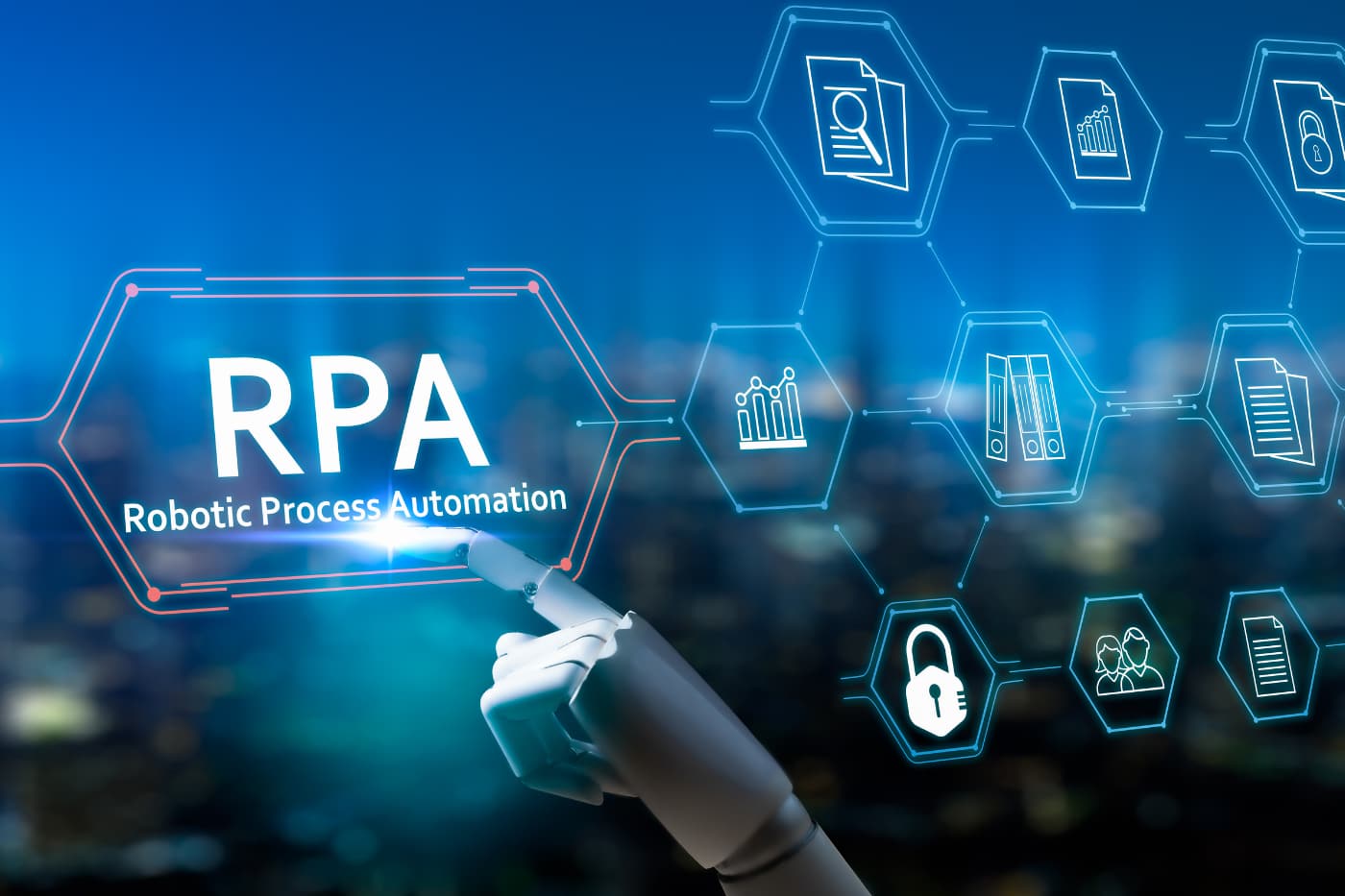Robotic Process Automation Tools Comparison: Which is Best?

We have often shared information about robotic process automation and its benefits. If you’re at the stage where you’re considering what type of tool you need, then let this robotic process automation tools comparison assist along your journey.
We’ll touch on what RPA is, the pros and cons, how to compare RPA tools, and which RPA tools stand out amongst the crowd.
Coming Up
2. Which RPA Tool is the Best?
3. What are the Pros and Cons of RPA?
4. What are the Types of RPA Tools?
5. How do you Compare RPA Features?
What is RPA?
Robotic process automation (RPA) uses programmable software bots to mimic human actions and carry out tasks. For standard robotic process automation, the data must be structured. If you’d like to apply robotic process automation to both structured and unstructured data, you’ll require intelligent RPA, which includes artificial intelligence for cognitive abilities.
Robotic process automation is best applied to tasks that are high in volume, repetitive, finite, and serve as a catalyst for additional business processes.
Which RPA Tool is the Best?
Depending on the size of your organisation, your processes, team culture, budget, and the like, you’ll have to decide what robotic process automation tool is your go-to. From hybrid, attended, and unattended solutions to those that do or don’t require coding knowledge, there are many factors to consider.
To aid in your decision, let’s take a look at the following robotic process automation tools comparison.
1. Solvexia
Solvexia is known as a human analytical automation tool. Although it is not technically a robotic process automation software, it does complement RPA strongly. This is because Solvexia has the power to connect data from all your systems and then transform it into valuable insights.
With customisable dashboards, end-to-end automation, and advanced analytics, business leaders have the ability to make informed decisions at any point in time. The system is low code meaning you don’t need an IT department to setup automation processes. Its also secure and connected, making it possible to digitise your workflows while standardising processes across the board.
Solvexia can be used to: perform reconciliations, prepare revenue reports, conduct forecasting, submit regulatory reports, and allocate/analyse expenses.
2. UiPath
Headquartered in New York, UiPath is a robotic process automation software that helps businesses perform both front and back office tasks. Their flagship product is the UiPath Automation platform which utilizes a low-code visual integrated development environment (IDE) to deploy and monitor processes with a central management tool.
Some of its features include: scrapping functionality, hosting options (virtual terminal or cloud), scalability, and an in-built record so that users can record their actions.
3. Automation Anywhere
Automation Anywhere is a popular RPA tool that makes it possible to automate complex business tasks. It also provides an end-to-end automation strategy. The web-based management system can be used to deliver scalable and secure services for its users.
The software doesn’t require coding knowledge to get up and running, instead users can take advantage of the recorders and task editor. It has built in governance controls and is easily scalable.
4. Blue Prism
Blue Prism is based on java programming language and uses a top down approach with a visual designer to carry out RPA functions (there is no recorder or script necessary). Blue Prism can automate an infinite amount of tasks, provides a data dashboard for analytics, and is scalable through its central management.
5. Kryon
Kryon’s automation platform is intended for a business user, meaning that no IT or coding knowledge is necessary in its deployment. The software provides findings in real-time and can also recommend processes for automation through the Kyron Process Discovery Tool.
Users can choose between attended, unattended, or hybrid bots (depending on how much human intervention is desired).
6. Appian
Appian robotic process automation provides full-stack automation by combining artificial intelligence, business process management, and case management to organisations. With a central management system, organisations can scale their bots without sacrificing oversight and transparency.
The software runs on Appian’s Cloud, which has enterprise-grade security. The bots are led by Java methods and libraries to design their workflows.
What are the Pros and Cons of RPA?
There are a myriad of upsides for implementing RPA within your business. But, there are also some concerns you’ll want to review before choosing it as your optimal solution. RPA can manage a lot of tasks, but it cannot automate everything.
It’s used on low-level and repetitive tasks that use structured data.
That being said, there are a lot of pros of RPA, including:
- Employee satisfaction
- Increased productivity
- Reduction in errors
- Agility and speed
The cons of RPA include:
- Implementation (each tool requires a different upfront cost and time to deploy)
- Risk (depends on what tasks you are trying to automate)
- Maintenance (if your business is likely to change greatly in the future, reconsider if RPA is your best solution)
- Sustainability (RPA is a great entrance into automation, but it may not always be enough. Consider complementing your RPA with an enhanced automation software like Solvexia)
If you are looking for more advanced benefits, a complimentary tool like Solvexia can provide you with many time-saving and cost-cutting solutions for your business. Solvexia is an analytical automation software that easily interacts with your existing data systems. Some of the most popular use cases of Solvexia include: account reconciliations, regulatory reporting, forecasting, expense analysis, and more.
What are the Types of RPA Tools?
There are various types of RPA tools to choose from, namely:
- Programmable RPA Bots: The first-generation of RPA tools need to be programmed with inputs
- Self-Learning Bots: Alternatively, you can select an RPA solution that can learn from screen capture videos and log data in order to copy human actions
- Intelligent Robotic Process Automation: When RPA is compounded by artificial intelligence, it becomes intelligent RPA, which can utilise functions like natural language processing and image recognition to work with unstructured data, too
How do you Compare RPA Features?
There are multiple considerations to compare when choosing the right robotic process automation tool for your needs.
When looking at your robotic process automation tools comparison, be sure to consider the following attributes:
- Security: RPA bots deal with sensitive customer and business information on a daily basis. As such, you need to select a solution with utmost security features and regular updates. Some factors to consider are tools that support regulations like HIPAA, SOX, or PCI DSS, to name a few.
- Cost: Cost will be a primary consideration when picking between tools. Keep in mind that you have to calculate the setup costs, vendor license fees, and any required maintenance costs. Ask the vendor you’re shopping about what these fees will be in advance to agree to anything.
- Usability: RPA is an “entry-level” automation software, so you’ll want it to be usable by every person within your organisation, regardless of how much technical acumen they may or may not have. That’s why an easy-to-use interface can make all the difference.
- Management: Check out how easy it is to manage the bots and how much visibility the software allows for. These bots make up a digital workforce, so you’ll want adequate oversight.
- Cognition: If you need to work with unstructured and structured data, then you may need to select a solution with intelligent RPA so there are cognitive abilities.
- Scalability: Change is inevitable in both life and business. As such, be sure to consider how your RPA tool will scale or adapt to business demands, requirements, regulations, and operations.
What is the Future of RPA?
Grand View Research reports that the global robotic process automation market size is expected to grow at 32.8% between the forecast period of 2021 to 2028. Per the source, the market will continue to progress because of the increasing need to automate redundant tasks and because RPA provides a quick solution to deal with large amounts of data in business settings.
Furthermore, technology progresses exponentially. This means that RPA advancements will continue to propel businesses forward with easier to use automation solutions and data centralisation. Organisations are able to standardise their global processes, regardless of location or industry because RPA can be programmed and then run infinitely.
Wrap Up
While this robotic process automation tools comparison offers an introductory and high-level review of some of the best options, there are many other software solutions to consider. Along with your robotic process automation needs, you can deploy Solvexia to maximise your team’s productivity, reduce human errors, and ensure compliance for all your business processes.
FAQ
Intelligent reconciliation solution
Intelligent rebate management solution
Intelligent financial automation solution
Intelligent Financial Automation Solution
Intelligent financial automation solution
Intelligent financial automation solution
Intelligent financial automation solution
Intelligent financial automation solution
Intelligent regulatory reporting solution
Free up time and reduce errors
Recommended for you

Request a Demo
Book a 30-minute call to see how our intelligent software can give you more insights and control over your data and reporting.

Reconciliation Data Sheet
Download our data sheet to learn how to automate your reconciliations for increased accuracy, speed and control.

Regulatory Reporting Data Sheet
Download our data sheet to learn how you can prepare, validate and submit regulatory returns 10x faster with automation.

Financial Automation Data Sheet
Download our data sheet to learn how you can run your processes up to 100x faster and with 98% fewer errors.

Financial Automation Data Sheet
Download our data sheet to learn how you can run your processes up to 100x faster and with 98% fewer errors.

Financial Automation Data Sheet
Download our data sheet to learn how you can run your processes up to 100x faster and with 98% fewer errors.

Financial Automation Data Sheet
Download our data sheet to learn how you can run your processes up to 100x faster and with 98% fewer errors.

Financial Automation Data Sheet
Download our data sheet to learn how you can run your processes up to 100x faster and with 98% fewer errors.

Financial Automation Data Sheet
Download our data sheet to learn how you can run your processes up to 100x faster and with 98% fewer errors.

Rebate Management Data Sheet
Download our data sheet to learn how you can manage complex vendor and customer rebates and commission reporting at scale.

Top 10 Automation Challenges for CFOs
Learn how you can avoid and overcome the biggest challenges facing CFOs who want to automate.
.svg)








%25201.webp)